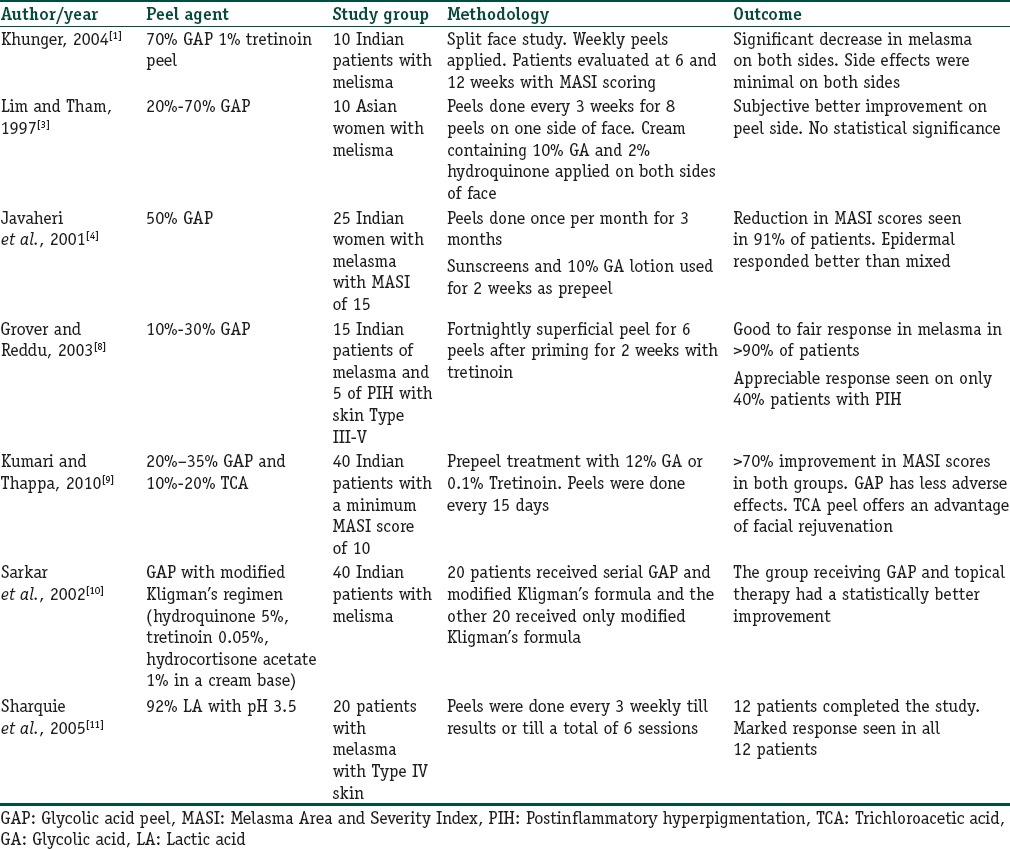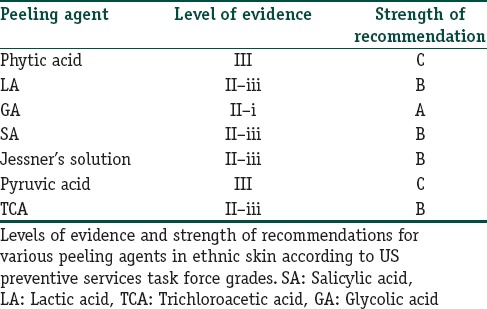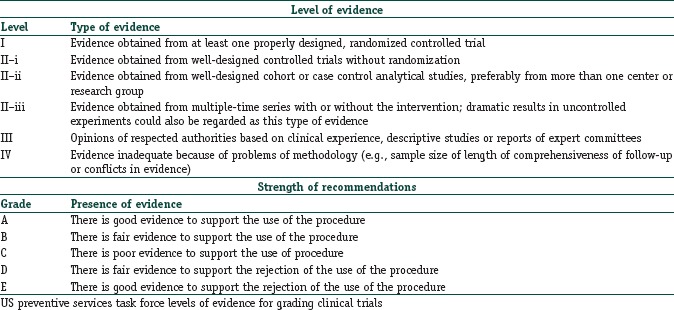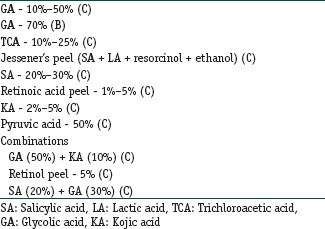Abstract
Melasma is a notorious dermatosis, often resistant to treatment. Chemical peeling constitutes an acceptable option of management of melasma (of any type and duration). In this article, as a group of experts from Pigmentary Disorders Society (PDS) in collaboration with South Asian Pigmentary Forum (SPF), we have tried to elaborate the various chemical peeling agents for the treatment of melasma. Besides, we have reviewed the indications, mechanism of action, rationality and the detailed procedure of peeling. The evidence in favor of various peeling agents have been summarized as well.
Keywords: Chemical peels, consensus, expert opinion, melasma
What was known?
Treatment of melasma is a multimodality approach. Chemical peels constitute the second-line of management in melasma, improving the epidermal component. However, peels are better avoided in dermal melasma, because of the chances of developing scars and post-inflammatory dyschromias. Proper patient selection, good counseling, priming of skin, and post procedural use of topical therapies are essential to achieve the desired effects of peeling.
Introduction
Melasma is a common chronic refractory acquired hyperpigmentation of the skin having a serious impact on the quality of life and is challenging to treat. Treatment is often a multimodality approach. Due to the psychological and social stress attached to it, it is important to counsel the patients adequately about disease chronicity, the importance of photoprotection and role of hormones in disease persistence before embarking on therapeutic correction, as improvement of whatever degree is often limited by recurrences. Hence, melasma is a challenge to treat even by the best of interventions.
Topical therapies are the mainstay of treatment for melasma and form the primary mandatory step of single, dual, or triple combinations. Other interventions are often second- or third-line approach and constitute the adjunctive protocol.
Chemical peels are a well-known modality of treatment and forms the second-line of management in melasma and may be helpful in improvement of its epidermal component. The dermal component is handled by the ability of peel to induce phagocytosis of stagnant melanin. However deep chemical peeling for a dermal component of melasma is not recommended in skin types IV to VI since it can lead to scarring and severe dyschromias. Sequencing peels with a triple combination topically have shown a better efficacy in moderate to severe melasma when measured by spectrometry.[1] This article discusses available evidence and brings forward suggested treatment guidelines by 15 experts from Pigmentary Disorders Society (PDS) in a collaborative discussion called South Asian Pigmentary Disorders Forum (SPF).
Rationale
Chemical peels have the capability of causing controlled epidermal dyscohesion and subsequent regeneration. The peeling agent causes superficial effects, i.e., enables removal of epidermal melanin as well as melanin from the keratinocytes, halts melanosome transfer to keratinocytes, hence being an indespensible modality in the treatment of melasma. The type of chemical, its concentration, number of coats applied and duration of application are the main factors which affect the efficacy and adverse effects as well.[2] Accordingly, the results may be variable with same or different agents in different patients and can be repeated and rotated as and when needed for optimal effects. Proper patient selection, good counseling, priming of skin, and post peels use of topical therapies to maintain the outcome and to prevent postinflammatory hyperpigmentation (PIH) are essential. Literature evidence reflects that clearance of melasma is better and faster when chemical peels are combined with topical therapy. Risk of PIH in skin of color looms large with medium and deep peels, and they need to be used with caution under cover of vigilant priming and sun protection.
Indications
Melasma with predominant epidermal pigmentation
Focal or pan facial.
Contraindications for peels in melasma
Prolonged duration
Strong dermal pigmentation
Unrealistic patient expectations
Active infections/inflammation
Photosensitivity.
Basics before a peeling procedure
History
Duration of melasma
History of skin infections, e.g., herpes virus infection
History of drug intake (photosensitizing medication, isotretinoin (medium depth peels), oral contraceptives, immunosuppressives)
History of allergy to any topical or systemic drug
Occupational history and outdoor hobbies
Treatment in the past 3 months with medium depth or deep chemical peel
Previous facial surgeries
Smoking
Keloid formation
Examination
Evaluate for;
Skin type of patient as per Fitzpatrick's classification
As a guide to selection of peeling agent
Degree of photodamage and photoaging as per Glogau system
Present skin condition (s/o excessive dryness, broken, infected, or wounded skin)
Signs of sensitive skin
Dryness
Redness
-
Conditions that require correction.
For example,
Acne
Any other disorder of pigmentation (e.g., PIH)
Presence of hypertrophic scars or keloids.
Prepeel work up
Counseling
Explanation regarding realistic expectations
Detailed discussion about the nature of treatment, time taken, and expected outcome
Explanation about the possible side effects
Informed consent
Photodocumentation
Melasma evaluation
Melasma Area and Severity Index score
Woods lamp examination to determine epidermal or dermal nature of pigmentation
Dermoscopy
Skin biopsy when indicated.
Sun Protection Factor
This is the absolute mandatory step in treating melasma. A broad spectrum sunscreen with an inorganic filter of Sun Protection Factor (SPF) 30 is necessary and should be started at first consultation.
Priming
Priming in melasma is essential for at least 4[2,3,4] weeks before the procedure. For 4% hydroquinone, at least 4 weeks of priming is necessary. It not only ensures a uniform penetration of the reagent but also reduces the risk of complication. Hence, choosing the right and specific priming agent is essential.[1,2,3,4]
Hydroquinone
Hydroquinone (HQ) (2%–4%) is the gold standard for priming. The depigmenting effects of HQ treatment become evident after 5–7 weeks. Treatment should be continued for at least 3 months as maintenance with peels.
Peels can be added after 4 weeks of HQ which should be stopped 1 day before peels and resumed a day after for superficial peels.
Retinoids
Retinoids as priming agents can be used alone or in combination with kojic acid (KA), arbutin or glycolic acid (GA). Tretinoin is the most commonly used retinoid for the purpose. Ideally, it should be started 2-4 weeks before the procedure and stopped a day prior.
Adapalene and tazarotene can also be used for priming. Adapalene has the advantage of less irritation than tazarotene and tretinoin.
Glycolic acid
GA is the most widely used Alpha Hydroxy acids (AHA) for priming. Nearly 6%–12% GA is a good priming agent for peels in melasma and can be combined with tretinoin or HQ. It is started at least 2-6 weeks before peels and stopped a week before and reintroduced 2 days post procedure.
Kojic acid
KA is more effective in combination with other agents when used twice a day for 1–2 months. Started 4 weeks before peels and stopped for a day before and reintroduced 1 day post peeling. Although it has a high sensitizing potential KA is useful in patients who cannot tolerate HQ.
Priming agents when combined, add to the synergistic preparation of melasma skin before any form of interventions are initiated. A dual or triple combination cream may be chosen with or without HQ. Retinoid in the triple combination may increase irritation potential of any peeling agent even in low strength and hence need to be withdrawn a week before peels. The disadvantage of retinoids is thinning of stratum corneum with resultant irritation and increased photosensitivity in some patients. A good emollient should be added while priming with retinoids. One must also ensure to defer a peel procedure when patients exhibit retinoid dermatitis. It should be initiated only when the dryness and inflammation subsides.[5]
Peels Under Consideration for Melasma
The important category of peels being considered here are AHA peels (e.g., GA, mandelic acid) and Beta Hydroxy acids (BHA) peels (e.g., salicylic acid (SA) and combination peels like Jessner's) and Tretinoin peels.[1,3,4,6,7,10,11,13,15,17,18,19,20]
Important studies on peels in melasma are discussed in Table 1. GA and SA peels are useful in most cases of melasma. “Spot peeling” of discrete areas of hyperpigmentation may also be useful since it would reduce the contrast between the normal skin and melanotic macules. It may also act as a test area when higher strength peels such as 25% trichloroacetic acid (TCA), Jessner's solution or SA is used.[6] The levels of evidence and strength of recommendations of various peeling agents in the ethnic skin for melasma are described in Table 2 [Appendix 1 and 2].[5,7]
Table 1.
Literature evidence of efficacy of peels in melasma

Table 2.
Levels of evidence and strength of recommendations for peels

Alpha Hydroxy Acid Peels
Glycolic acid peel
This extremely hydrophilic reagent works by decreasing keratinocyte cohesion at low concentration and by epidermolysis at higher concentration. For melasma peeling, it is used in a concentration of 30%–70%. Two to three weeks apart weekly sessions are conducted for a series of 4–6 sessions. Although gel based peel is preferred for sensitive skin, aqueous solution has higher bioavailability of free acid and are preferred over gel based peels for cosmetic results.
Various studies in skin of color highlight the value of GA peels. Some studies reported superior results when GA concentration was as high as 50% with topical therapies.[8] Few other studies emphasize the significance of its increased efficacy when 30%–40% GA peels are combined with topical therapies such as topical 10% GA,[1] modified Kligman's formula,[9] topical vitamin C, azelaic acid, and adapalene.[10]
Level of Evidence-II-I
Strength of recommendation-A
Lactic acid
Lactic acid (LA) is a small molecular weight AHA and have proved beneficial when used as 92% strength at pH 3.5 with double coats, which are applied for 10 min every 3 weeks for epidermal melasma. It has been compared to Jessner's peel and found to be safe and efficacious.[11]
Level of Evidence-II-III
Strength of recommendation-B
Mandelic acid
Mandelic acid at 10%–50% applied weekly or biweekly is another peeling agent used in melasma. Its advantage over other agents is its anti-inflammatory effect, thus causing less erythema and its synergistic effect with other peels and lasers.[4]
Phytic acid combination peels
Phytic acid is a large molecular weight AHA. It is used as a mild superficial peel and has antioxidant properties. It is commercially available as a combination peel with GA, LA and mandelic acid. It is used as self-neutralizing solution which can be left onto the skin. It can be used for sensitive skin. In melasma, it can be used twice a month for 4–5 sessions.[4,12]
Level of Evidence-III
Strength of recommendation-C
Beta hydroxy acid peels
Salicylic acid peel
SA peels in 20%–30% strength help in the elimination of epidermal pigment in well-primed patients of melasma. By its lipid solubility, it has a better keratolytic action and a smoother post peel texture. Grimes conducted five SA peels 20% and 30% in patients pretreated with HQ 4% and obtained moderate to significant improvement in 4 of 6 dark skinned patients with melasma. Hyperpigmentation was observed more in patients who were on nonHQ priming agents.[13,14]
Level of Evidence-II-III
Strength of recommendation-B
Trichloroacetic acid peel
TCA peel work on the principle of causticity. In the lower strength of 15%, TCA can be used as a superficial peel and at a higher strength of 35% it acts as a medium depth peel. The sessions can be conducted at the monthly interval for about four sessions and can be done as 1–2 coats on melasma zone and a single coat pan facially. It is a self-limiting peel and the end point is frosting, which acts as a guide to the depth of peeling. Even with low strength formulation, one has to be vigilant about the possibility of PIH, especially in the skin of color. A single coat of TCA peel creates a superficial peel. Increasing number of coats can make it medium depth. Frosting here acts as a guide to depth. A comparative study of TCA versus GA peels in the treatment of melasma reported that GA peel is associated with fewer side effects than TCA and has the added advantage of facial rejuvenation.[9] Kalla reported degree of response was better with TCA but relapses were more common.[15] Topical ascorbic acid combined with 20% TCA peel in melasma improves the results and helps in maintaining the response to therapy[16] and better when TCA is used along with modified Jessner's peel.[17]
Level of Evidence-II-III
Strength of recommendation-B
Jessner's peel
It is a combination of an AHA (LA) with a BHA (SA) along with resorcinol, a phenol derivative. As a superficial peeling agent it works well for all skin types. As a medium depth peel, it is used in combination with other agents such as GA and TCA. In a study conducted on melasma by Safoury et al., a combination of 15% TCA with modified Jessner's was compared with only 15% TCA, and the results were found to be better with combination peels.[17]
Level of Evidence is II-III
Strength of recommendation-B
Retinoic acid peel (tretinoin)
Tretinoin peels are useful in melasma, wherein 5%–10% tretinoin is applied as a slow release peel and helps to eliminate epidermal pigment, reduces photodamage, and improve skin texture. It is beneficial as the patients are already primed with topical tretinoin alone or in triple combination therapy. Tretinoin peels versus GA peels in the treatment of melasma in dark-skinned patients has been studied by Khunger et al. in Indian patients where tretinoin peel at 1% strength is applied for 4 h once a week for 12 weeks and found to be of equal efficacy.[1]
Strength of recommendation-C
Some authors have found good results in melasma after peeling with retinol.[1]
Different ethnicities in the Fitzpatrick skin type IV-VI may react variedly to the chemical agents used for peeling in melasma.
Practical Considerations
Good priming and strict sun protection ensures adequate suppression of neomelanogenesis and reduces the risk of PIH after peels
Peels yield a good result in epidermal melasma of <1 year duration. Peels are helpful to improve epidermal pigmentation. Superficial chemical peels have no role on the dermal pigment. Peels have to be combined with topical therapy and maintenance treatments with topical agents is mandatory to prevent recurrence.[6]
Postprocedure Care
To reduce the risk of complications and ensure quick recovery of normal skin, optimum postprocedure care is essential. This is in accordance with the condition being treated.
Ice compress: immediately post procedure to reduce discomfort
Emollients: in case of excessive desquamation
Broadspectrum sunscreen: essential to prevent erythema and PIH, especially in darker skin types
Maintenance: resumption of lightening creams and maintenance peels.
Conclusion
Although topical therapy forms the cornerstone of the treatment of melasma, as an adjuvant and maintenance therapy, chemical peels have the capacity to bring about excellent cosmetic improvement. As a general consideration, very superficial and superficial depth peels are safer in Indian patients. There is a plethora of information over the type of peel for various types of melasma. Through this article, we intend to set guidelines which will provide a quick referral aid in deciding on the type of peel to be used in a particular patient. This will not only help in curating a stepwise approach for the management of melasma but also increase the scope of further developments in its management.
Levels of evidence and strength of recommendations for various peeling agents in ethnic skin according to US preventive services task force grades.[1,3,4,7,10,11,13,15,17,18,19,20]
Financial support and sponsorship
Nil.
Conflicts of interest
There are no conflicts of interest.
What is new?
Priming should be done for peeling for at least 2-4 weeks.
Peels are second line treatment for melasma and work well in combination with other agents.
Emollients can reduce irritation with topical priming agents.
A single coat of peel with a second spot peel helps to decrease area of differences between hyperpigmented and nonpigmented areas.
Superficial combination and proprietary peels are better tolerated than conventional peels even in sensitive skin.
Acknowlegment
The Consensus Meeting of a group South Asian Pigmentary Disorders Forum (SPF) with Pigmentary Disorders Society (PDS) was made possible by an educational grant by Galderma, India.
Appendix 1. Levels of evidence and strength of recommendations at a glance

Appendix 2. Evidence based peels for melasma

References
- 1.Khunger N, Sarkar R, Jain RK. Tretinoin peels versus glycolic acid peels in the treatment of melasma in dark-skinned patients. Dermatol Surg. 2004;30:756–60. doi: 10.1111/j.1524-4725.2004.30212.x. [DOI] [PubMed] [Google Scholar]
- 2.Resnik SS, Resnik BI. Complications of chemical peeling. Dermatol Clin. 1995;13:309–12. [PubMed] [Google Scholar]
- 3.Lim JT, Tham SN. Glycolic acid peels in the treatment of melasma among Asian women. Dermatol Surg. 1997;23:177–9. doi: 10.1111/j.1524-4725.1997.tb00016.x. [DOI] [PubMed] [Google Scholar]
- 4.Javaheri SM, Handa S, Kaur I, Kumar B. Safety and efficacy of glycolic acid facial peel in Indian women with melasma. Int J Dermatol. 2001;40:354–7. doi: 10.1046/j.1365-4362.2001.01149.x. [DOI] [PubMed] [Google Scholar]
- 5.Arsiwala S. Chemical peels for melasma. In: Sarkar R, editor. Melasma a Monograph. 1st ed. New Delhi: Jaypee Brothers Medical Publishers; 2015. pp. 54–62. [Google Scholar]
- 6.Roberts WE. Chemical peeling in ethnic/dark skin. Dermatol Ther. 2004;17:196–205. doi: 10.1111/j.1396-0296.2004.04020.x. [DOI] [PubMed] [Google Scholar]
- 7.Sarkar R, Bansal S, Garg VK. Chemical peels for melasma in dark-skinned patients. J Cutan Aesthet Surg. 2012;5:247–53. doi: 10.4103/0974-2077.104912. [DOI] [PMC free article] [PubMed] [Google Scholar]
- 8.Grover C, Reddu BS. The therapeutic value of glycolic acid peels in dermatology. Indian J Dermatol Venereol Leprol. 2003;69:148–50. [PubMed] [Google Scholar]
- 9.Kumari R, Thappa DM. Comparative study of trichloroacetic acid versus glycolic acid chemical peels in the treatment of melasma. Indian J Dermatol Venereol Leprol. 2010;76:447. doi: 10.4103/0378-6323.66602. [DOI] [PubMed] [Google Scholar]
- 10.Sarkar R, Kaur C, Bhalla M, Kanwar AJ. The combination of glycolic acid peels with a topical regimen in the treatment of melasma in dark-skinned patients: A comparative study. Dermatol Surg. 2002;28:828–32. doi: 10.1046/j.1524-4725.2002.02034.x. [DOI] [PubMed] [Google Scholar]
- 11.Sharquie KE, Al-Tikreety MM, Al-Mashhadani SA. Lactic acid as a new therapeutic peeling agent in melasma. Dermatol Surg. 2005;31:149–54. doi: 10.1111/j.1524-4725.2005.31035. [DOI] [PubMed] [Google Scholar]
- 12.Usuki A, Ohashi A, Sato H, Ochiai Y, Ichihashi M, Funasaka Y, et al. The inhibitory effect of glycolic acid and lactic acid on melanin synthesis in melanoma cells. Exp Dermatol. 2003;12(Suppl 2):43–50. doi: 10.1034/j.1600-0625.12.s2.7.x. [DOI] [PubMed] [Google Scholar]
- 13.Grimes PE. The safety and efficacy of salicylic acid chemical peels in darker racial-ethnic groups. Dermatol Surg. 1999;25:18–22. doi: 10.1046/j.1524-4725.1999.08145.x. [DOI] [PubMed] [Google Scholar]
- 14.Ahn HH, Kim IH. Whitening effect of salicylic acid peels in Asian patients. Dermatol Surg. 2006;32:372–5. doi: 10.1111/j.1524-4725.2006.32075.x. [DOI] [PubMed] [Google Scholar]
- 15.Kalla G, Garg A, Kachhawa D. Chemical peeling – Glycolic acid versus trichloroacetic acid in melasma. Indian J Dermatol Venereol Leprol. 2001;67:82–4. [PubMed] [Google Scholar]
- 16.Soliman MM, Ramadan SA, Bassiouny DA, Abdelmalek M. Combined trichloroacetic acid peel and topical ascorbic acid versus trichloroacetic acid peel alone in the treatment of melasma: A comparative study. J Cosmet Dermatol. 2007;6:89–94. doi: 10.1111/j.1473-2165.2007.00302.x. [DOI] [PubMed] [Google Scholar]
- 17.Safoury OS, Zaki NM, El Nabarawy EA, Farag EA. A study comparing chemical peeling using modified jessner's solution and 15% trichloroacetic acid versus 15% trichloroacetic acid in the treatment of melasma. Indian J Dermatol. 2009;54:41–5. doi: 10.4103/0019-5154.48985. [DOI] [PMC free article] [PubMed] [Google Scholar]
- 18.Sharquie KE, Al-Tikreety MM, Al-Mashhadani SA. Lactic acid chemical peels as a new therapeutic modality in melasma in comparison to jessner's solution chemical peels. Dermatol Surg. 2006;32:1429–36. doi: 10.1111/j.1524-4725.2006.32352.x. [DOI] [PubMed] [Google Scholar]
- 19.Berardesca E, Cameli N, Primavera G, Carrera M. Clinical and instrumental evaluation of skin improvement after treatment with a new 50% pyruvic acid peel. Dermatol Surg. 2006;32:526–31. doi: 10.1111/j.1524-4725.2006.32106.x. [DOI] [PubMed] [Google Scholar]
- 20.Sobhi RM, Sobhi AM. A single-blinded comparative study between the use of glycolic acid 70% peel and the use of topical nanosome vitamin C iontophoresis in the treatment of melasma. J Cosmet Dermatol. 2012;11:65–71. doi: 10.1111/j.1473-2165.2011.00599.x. [DOI] [PubMed] [Google Scholar]


